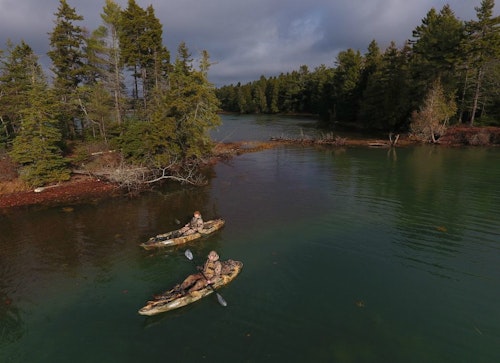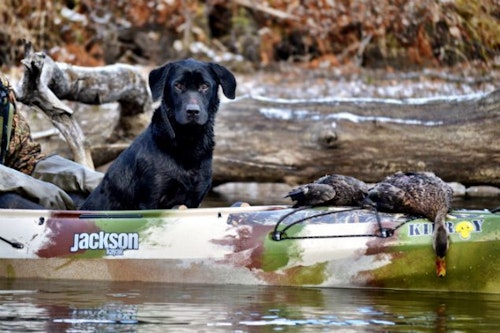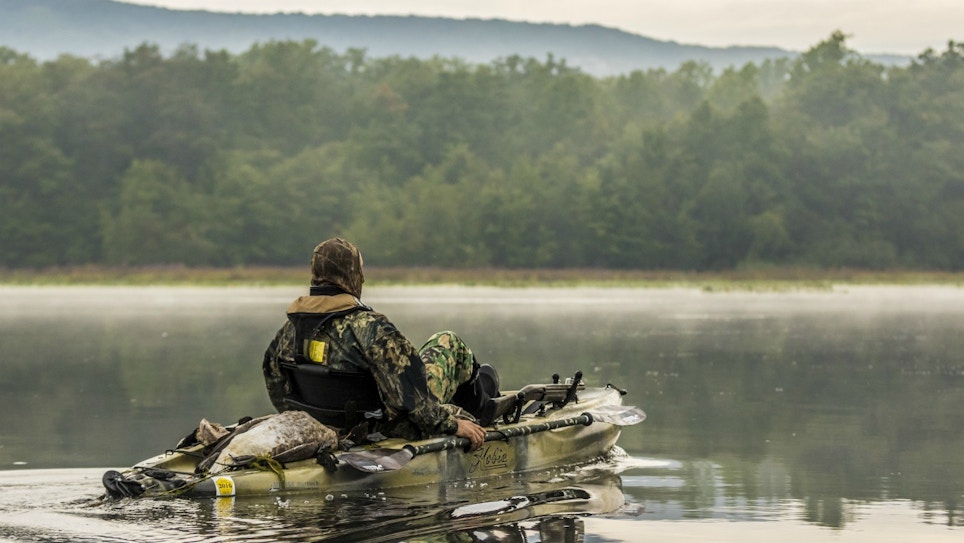Paddlesports popularity is soaring. In the most recent survey, participation increased 7 percent in four years. Now, 21 million American use some kind of paddling boat — canoe, kayak or paddleboard. At the top of the heap are kayaks. More than 13 million Americans kayaked in 2014, the latest research available.
Fishing is the most popular outdoor activity, with 35 percent participation. In the Outdoor Foundation’s Outdoor Participation Report, less than 20 percent of kayakers are now using them to hunt. But according to retailers, the number of sportsmen and women using a kayak for hunting is growing. Why? It’s all about access. Hunters want to get to where others cannot and find their own adventures off the beaten path.
If you’re not carrying kayaks in your store, are you missing out on solid margin? Some in the industry say kayaks represent a 30 to 40 percent margin. If you do offer them to customers, are you displaying them correctly and upselling new propulsion technology?
We talked to a number of people in the industry — from retailers to manufacturers and kayakers — in order to help you decide if there is an opportunity here for your business. Maybe 2020 is the year to increase store sales by bringing in kayaks, the rockstar of the paddlesports space.
Access Is the Selling Point
Access is the main reason why small paddlesport boats have been so popular among hunters. As a public-land hunter myself, I am always trying to outsmart other hunters as well as the deer and ducks. A kayak is quiet and helps me get into shallow creeks and marshes where few others can go.
“If stores pitch kayaks in that light, they’ll be successful,” said Damon Bungard of Jackson Kayaks.
Bungard is also a hunter, and he uses his Jackson Kayak Kilroy HD to get deep into the outback in his home state of Tennessee. He found there are many places across the country where a kayak would give a hunter an edge. And what hunter isn’t looking for an edge?
Bungard recently went duck hunting with a friend in Vermont. They launched at a ramp and quietly pedaled into a back-bay slough off Lake Champlain. The had a limit by noon, and paddled back.
“We got to the ramp, and there were a whole lot of guys amazed that we got our limit so soon,” said Bungard. “They said, ‘Where were you guys?’ We said, ‘Where you weren’t.’ ”
Morgan Promnitz, Hobie’s senior brand manager, said Hobie sees the access issue as the driver of future profits for his company and for retailers.
“We think that access to different hunting ground is a very appealing thing about getting a kayak,” he said. “They’re silent, stealthy, lightweight and inexpensive. Plus, you can portage them, and that opens a whole world to hunters and fishermen. As a company, we feel that is the strongest marketing angle and has a potential for strong growth in the near future.”

Floor-Space Challenges
But there’s an 800-pound gorilla in the room. You’ll have to make room for a handful of 14-foot-long, 100-plus-pound kayaks in your store. Or do you?
Each retailer we spoke to had a different way to inventory or display their kayaks as well as boats and canoes. And each had advice for other retailers. They said that displaying outside has advantages and disadvantages.
The advantage is, they look great from the road. A kayak or two, full-rigged as a fishing or hunting tool, will attract customers to the store, especially if you are on a busy highway and you need to get sportsmen to pull into your drive. They’re like magnets.
The downside is that weather will take its toll pretty quickly, and then you may have a harder time selling it. It’s true that good quality kayaks all have UV inhibitors in the plastic, but dust and leaves will diminish the brand-new quality of the boat, and it will be less appealing and more like a scuffed floor model in no time. Some retailers recommended bringing them out only for special promotions and otherwise storing them inside or at least under a roof.
Some retailers have enough floor space to show them inside. Again, a fully rigged model — with rods, coolers and lure boxes if it’s for fishing or a gun-holder, ammo box and camo netting — is about as sexy of a product as you could produce from any aisle of your store. What’s nice about this is that you can put a gun or fishing rod in the kayak and, unlike being outside, people with sticky fingers would have a hard time walking off with them.
Again, floorspace is usually a premium in most smaller and mid-sized retailers across the country, so this beautiful display style might not be right for you. While some retailers display one or two outside or rig one up inside, they almost all display others vertically, lined up along any wall, railing or anywhere there’s room (one retailer in Illinois stands them up in his bow range, “but in a way no arrow would hit them,” he said). In this configuration, customers can still touch them and see the accessory rail system. Many larger retailers address the display issue by having just one in the store and then warehousing other options on site or off-site nearby.
The Shape of Shipping
Shipping costs are another obstacle that retailers point to when considering offering boats and kayaks. One retailer in Utah mitigates that by working with a local company — Lifetime Kayaks.
“For my customers, price is important, so I have to keep all costs down,” said Mike Vause of Smith & Edwards in Ogden, Utah. Vause looked around for a close supplier and found that Lifetime Kayaks was just 20 miles down I-15 from their store.
“We go down and pick up a few kayaks whenever we need to,” said Vause. Otherwise, when he orders from other companies, especially manufacturers back East, shipping costs get high quickly. Depending on the size of the kayaks, which run from about 6 feet to 17, it only takes 20 to about 45 to fill up a whole truck.
Said Vause: “Any retailer looking to carry kayaks or boats should first determine where they’ll be getting their supply from and calculate in shipping costs. They might surprise you.”
Every retailer has to deal with shipping costs. Promnitz of Hobie said he sees some reaching out to others, even competitors, to share shipping costs.
“Many dealers work together and share costs when they can,” said Promnitz. “And it’s in their best interest not to undercut another business for a short-term gain. If a customer calls four different stores and they are all around the same price, then the stores will have a good margin.”

Models and Colors
Once you have a plan to control shipping costs, then it’s time to figure out what make, model, propulsion and colors to order. Most kayak companies are producing kayaks not necessarily for hunting, but for sportsmen’s use, and they are letting the accessories companies build items to fit on their rails and modular fittings. That’s fine for 99 percent of hunting with a kayak, but it’s the companies that are looking specifically at hunting with a kayak that are excelling at making a user-friendly, practical craft for hunting. For example, Bungard and his development team at Jackson realized that the Kilroy had a lot of good storage for duck hunting and big-game hunting. But when strapping a treestand to the bow deck, the convex forward area made it tough to securely strap down. Similarly, when they harvested a buck or doe, the rounded deck made it tough to tie the carcass down for the paddle home. In their next iteration of the model, the deck will be concave.
From Hobie, their Pro Angler makes a good crossover for the big-game hunter. The model has been around for years, but it can now carry 600 pounds of cargo and has large cargo areas.
“You can easily put a deer or a hog in there,” said Promnitz. “I have a friend in Florida who just killed her second alligator, and she hauls them back in her kayak.”
Modifications like these that evolve over a few models make all the difference to the hard-core sportsman who have to live with the purchase for many seasons.
But will even the best hunting kayak sell? It all depends on what’s going on in your region and if you’re buying the right model for your area. Of course, any manufacturer you call should be able to tell you what model is doing well in your neck of the woods. For example, along the ocean and Gulf coasts, sit-on-top kayaks are the most popular. Inland, sit-insides do better. Beyond that, you’ll need to choose length (longer, narrower kayaks for open water and when sportsman have to paddle long distances), weight (many kayaks now have a wheel built in, which mitigates weight), propulsion (paddles, pedal-drive or electric) and color. Regarding color, generally kayaks that are earth tones or camo sell best in early fall through winter. Bright colors kayaks are best for sales spring through summer, said Ryan Lilly of Johnson Outdoors, owners of Old Town Canoes and Ocean Kayaks.
“For retailers who are tentative about bringing in a full range of canoes or kayaks, I always suggest they choose a couple and firsthand test whether or not their customer base is receptive,” said Lilly.
Upsells
When it comes to accessories, kayaks are a lot like archery-hunting tackle. Bowhunters don’t just buy a bow and go hunting. They also buy arrows, broadheads, a rest and a sight. They get the setup tuned and are much more likely to return several times during season as compared to rifle hunters.
Vause of the Odgen store said that when the new buyers have success with their kayak, like if they harvest an animal or maybe enter a kayak bass-fishing series event and do well, then they’re hooked: “They upgrade quickly and go from oars to pedal drive to electric drives. It becomes a rabbit hole for them.”
Propulsion is a major upgrade opportunity for retailers. Advances in technology have given kayakers the option of pedal drives, like Hobie’s MirageDrive, or electric propulsion, like MinnKota’s Motor. The larger kayak companies have proprietary motors, but there are many aftermarket motors. Bevy’s Jet Drive can be used on any kayak with a rudder.
For the purposes of hunters, a few drives stand out. Hobie’s latest pedal-drive, Mirage 180, now has a kick-up feature that will really help you keep moving in shallow water when you hit a submerged log or rock. Sold with the Pro Angler, the package is about $3,900.
MinnKota Motor is a battery-operated prop that’s at the bottom of a drop-in box. It fits only two models of Old Town Predators (XL and MK) right now, but there’s hope that future models will all be compatible with this modular motor. Sold with the Predator, the package is about $3,000.
Other popular options include the Torqeedo Ultralight at less than 20 pounds with batteries and a retail of about $1,800. One of the latest options, the Bixpy Thruster, is rechargeable and weighs only 9 pounds. It’s about $1,100 and includes the power pack.
Dollars and Sense
Paddlesports popularity is soaring, and it’s expected to continue to rise. Perhaps more people are seeking out their own adventures so they can post cool backwater photos on Instagram. Others are bringing home meat to put on the family dinner table. Whatever the reason, customers have more kayak and accessory options than ever before. With research into your local market, the larger margins could make a lot of dollars and sense.






